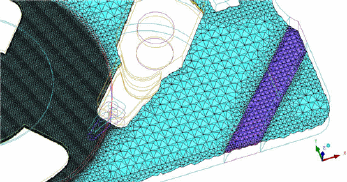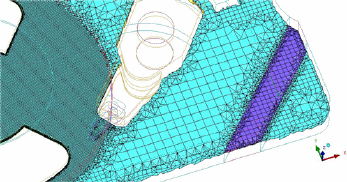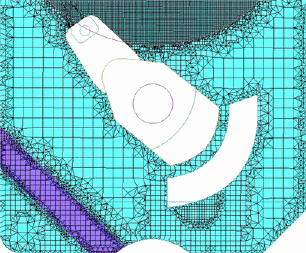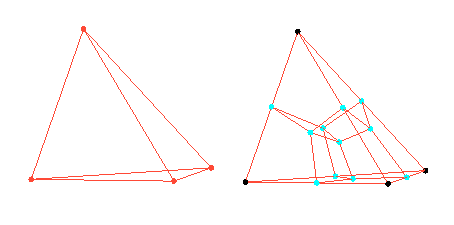 The Tetra to Hexa option allows you to convert tetrahedral
mesh to hexahedral mesh.
The Tetra to Hexa option allows you to convert tetrahedral
mesh to hexahedral mesh.
- Method
1 tetra to 4 hexa
This option will subdivide selected tetra elements into four hexa elements by creating a node at the center of the tetra, at the centroid of the tri faces of the tetra. The 4 hexa elements are created by connecting these nodes.
- Project nodes
If disabled, the midface nodes that are created will be left linear and will not be projected. If enabled, the node will be projected in the manner determined by the Normal to elements option.
- Normal to elements
If this is enabled, the node will be projected normal to the triangle face. If the angle between the normal direction and the projected point is greater than 5 degrees, then the node will be left unprojected. If this option is disabled, the node will be projected to the closest surface.
The Project nodes option will project new face nodes onto the geometry.
12 tetra to 1 hexa
Works on Octree generated mesh to convert groups of 12 tetras to 1 hexa element.
Note: This only works on Octree generated mesh because that algorithm started with Cartesian mesh which it converted to tetras with a 1 to 12 process.
The primary control is to specify the Min aspect ratio for the newly created hexa elements, clumps of tetras that would produce a hexa of lower quality are not converted. Pyramids are used to create a conformal interface between converted hexas and the surrounding tetra elements. Uniform regions of Octree mesh convert most effectively. Octree size transition regions cannot be converted; use density boxes to control where the size transitions happen (away from critical regions). Also, reducing the number of transitions (more uniform sizing) can result in a higher conversion rate. If the mesh against the surface is smoothed, it may not convert as well. You can disable surface smoothing (Octree tetra global mesh parameter) if you want hexas to the boundary. You can select either All tetra elements or elements from selected Volume element parts for the conversion.
In Figure 466: Example for Conversion of 12 Tetra to 1 Hexa, the Octree tetra mesh for a disk drive (figure (A)) is converted to an Octree hexa hybrid mesh (figure (B)). This example has a large number of transitions as well as prism elements. These transitions, smoothing, and non Octree element types reduce the conversion rate. From the count of element types before and after the conversion (TETRA_4 : 4220472 converted to TETRA_4 : 2004355 and HEXA_8 : 179262), note that the final number of elements is reduced by approximately half without coarsening the mesh.
Figure 466: Example for Conversion of 12 Tetra to 1 Hexa
(A) Octree Tetra Mesh With Prisms for the Disk Drive Before Conversion (B) Octree Hexa Hybrid Mesh for the Disk Drive After Conversion 



Element types:
NODE : 150
LINE_2 : 11493
TETRA_4 : 4220472
TRI_3 : 445817
PENTA_6 : 1788782
QUAD_4 : 2898
PYRA_5 : 11186
Element types :
NODE : 150
LINE_2 : 11726
TETRA_4 : 2004355
HEXA_8 : 179262
TRI_3 : 434319
PENTA_6 : 1748756
QUAD_4 : 11786
PYRA_5 : 176324
Note: Only tetras are converted, not prisms. Also, prisms cannot grow into hexa elements, so you need to maintain a layer of tetras near walls where you intend to grow prisms or insert prism layers before using the 12 Tetra to 1 Hexa. conversion.
Aligning the Octree mesh with the principal model directions (such as along a pipe or wall) can further increase the conversion rate and result in hybrid mesh that is better aligned with the flow.




